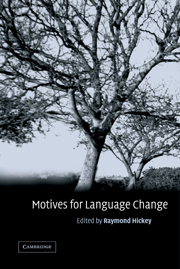Book contents
- Frontmatter
- Contents
- Notes on the contributors
- Acknowledgements
- Introduction
- Part I The phenomenon of language change
- Part II Linguistic models and language change
- Part III Grammaticalisation
- Part IV The social context for language change
- Part V Contact-based explanations
- 10 The quest for the most ‘parsimonious’ explanations: endogeny vs. contact revisited
- 11 Diagnosing prehistoric language contact
- 12 The ingenerate motivation of sound change
- 13 How do dialects get the features they have? On the process of new dialect formation
- Part VI The typological perspective
- Index
- References
12 - The ingenerate motivation of sound change
Published online by Cambridge University Press: 22 September 2009
- Frontmatter
- Contents
- Notes on the contributors
- Acknowledgements
- Introduction
- Part I The phenomenon of language change
- Part II Linguistic models and language change
- Part III Grammaticalisation
- Part IV The social context for language change
- Part V Contact-based explanations
- 10 The quest for the most ‘parsimonious’ explanations: endogeny vs. contact revisited
- 11 Diagnosing prehistoric language contact
- 12 The ingenerate motivation of sound change
- 13 How do dialects get the features they have? On the process of new dialect formation
- Part VI The typological perspective
- Index
- References
Summary
Introduction
This chapter investigates the interplay between phonetic (coarticulatory) and phonological (structural) factors surrounding two of the best-studied and most complex changes in Germanic, umlaut and the High German Consonant Shift. These well-studied data sets form the springboard for our primary thesis that the boundary between phonetics and phonology is largely porous, in the specific sense that the phenomena of the latter find motivation in the particulars of the former. The idea that phonetics is not entirely separate from phonology stands in notable contrast to the classic view encoded in lexical phonology's principle of structure preservation (Kiparsky 1985) and to the separatist position taken in some current theorising in phonetics itself (Cohn and Tsuchida 1999). At the other extreme, our porosity thesis stands apart from the tenet of especially ‘functional’ optimality theory (Kirchner 1997), which holds that even gradient phonetic properties should be accessible within the realm of contrastive phonology. Rather than raise up impermeable barriers between phonetics and phonology or erase extant distinctions between the two domains, however, this chapter charts the development of two celebrated, nominally unrelated sound changes from their phonetic inception in coarticulation to their emergence as overt constructs of the phonology. This is our general interpretation of the familiar life-cycle of sound change, in fact: the forces of coarticulation work to shape structure, whereas structure eventually comes to override the inherently coarticulatory grounding, or ingeneracy, of phonetic naturalness.
- Type
- Chapter
- Information
- Motives for Language Change , pp. 199 - 212Publisher: Cambridge University PressPrint publication year: 2003
References
- 4
- Cited by



